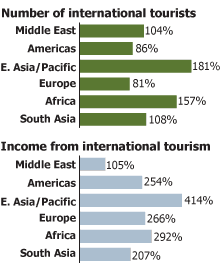Jonathan Nash
Former Policy Analyst

April 1, 2001
Former Policy Analyst
Eco-tourism has emerged as one of the most important sectors of the international tourism industry. The United Nations, recognizing eco-tourism’s potential role in sustainable development, has declared 2002 the “International Year of Eco-tourism.”
At its best, eco-tourism is responsible travel to natural areas that safeguards the integrity of the ecosystem and produces economic benefits for local communities that can encourage conservation. At the nexus of population and the environment, eco-tourism is a creative way of marrying the goals of ecological conservation and economic development.
Unfortunately, while some eco-tourism projects succeed in promoting both of these causes, others are less successful. Environmental deterioration and inequitable development may in some cases actually be exacerbated by eco-tourism. To ensure that eco-tourism fulfills its promise, policymakers, promoters, and participants should make sure that all tourism activities have minimal environmental impact, that such development is welcomed by local communities, and that it promotes stable and equitable economic development.
This fact sheet is designed to offer more insight into eco-tourism’s potential upside and downside as a development scheme.
Rise in International Tourism, by Region
Percent Increase Between 1985 and 1998

Source: World Tourism Organization, “Facts and Figures”
(www.world-tourism.org/frameset/frame_market_data.htm).
Successful eco-tourism requires maximizing its environmental and economic benefits while minimizing ecological damage and disruption of local communities. To achieve these goals, eco-tourism development should be carefully planned from the beginning, keeping in mind these key points:
In the Tambopata Candamo Reserved Zone in southeastern Peru, Rainforest Expeditions, a for-profit eco-tourism company formed by Peruvian conservationists, has entered into a joint eco-tourism venture with the Ese’eja Indian community to attract tourists to a biologically rich site boasting macaws, giant river otters, and harpy eagles. The indigenous community provides labor, lodging, and food for the project, and in return receives 60 percent of the profits from the joint venture. Rainforest Expeditions requires a strong degree of local participation and gives the community equal decisionmaking power in the management of this unique endeavour.
Both Rainforest Expeditions and the Ese’eja community realize that the success of their tourism venture depends on the protection of local wildlife resources. Accordingly, both sides are actively involved in research, management, and conservation programs to protect the fragile ecosystem. Since its inception, the site has become a highly-rated eco-tourism destination, developed innovative natural and cultural education programs, and played an increasingly important role in the conservation and sustainable development of the region.
Read a report the project in Peru’s Tambopata Candamo Reserved Zone at www.ecotourism.org.
The International Ecotourism Society www.ecotourism.org.
Planeta.com, a website that covers all kinds of environmental travel in the Americas www.planeta.com.
Conservation International’s EcoTravel Center www.ecotour.org.
World Tourism Organization www.world-tourism.org.
